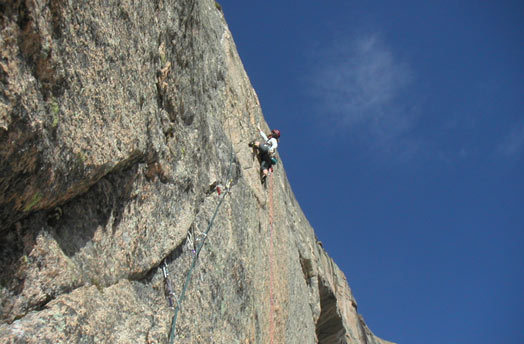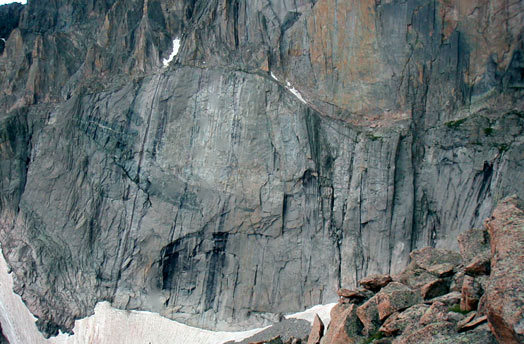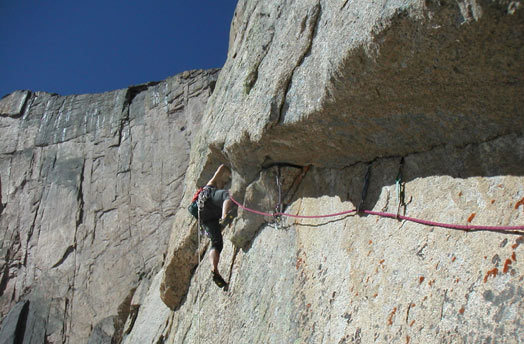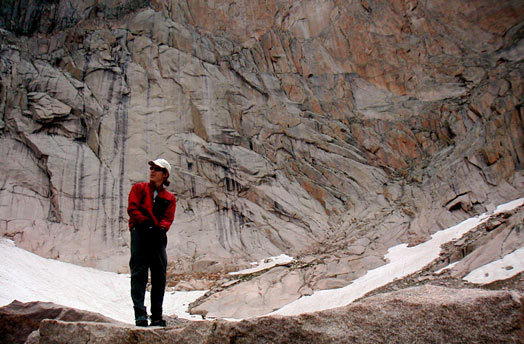
Chip Chace leading Pitch 2 (5.11b), Endless Summer (V- 5.12- [5.11 R], ca. 1,000′, Briggs-Chace, 2006), lower East Face, Longs Peak, Rocky Mountain National Park, Colorado.
[Photo] Roger Briggs
On July 31, Chip Chace and I completed the first ascent of Endless Summer (V- 5.12- [5.11 R], ca. 1,000′) on the lower East Face of Longs Peak. This was the first free climb of the Nassewand, as it was called in the 1960s, the 1,000-foot, Yosemite-like wall to the left of the Diagonal. During the late 1960s many attempts were made on this wall by the likes of Michael Covington, Wayne Goss and Larry Dalke, but no one found a way through the lower part of the wall with its giant wet arches. The wall was abandoned and sat untouched for almost twenty years.
In 1987 interest in the Nassewand rekindled with two different parties completing aid lines up the wall. Jim Beyer, rope-soloing, found a dry, elegant start just left of the wet arches and forged a line up to Broadway that he called Antinuclear Tide. Also that summer Dan McGee and Layton Kor climbed a similar line, finishing in a wet, vegetated crack, and named it Question Mark Wall.
The next year, Greg Davis and Todd Bibler began the project of finding a free climb up the Nassewand. They first found a way directly through the big wet arches that required several moves of aid on bolts, and continued to within a pitch of Broadway where the line stalled out. They called this line Slippery People (the aid moves through the arches were eliminated by Jonathon Copp in 2004).

The Endless Summer Wall, lower East Face, Longs Peak, Rocky Mountain National Park, Colorado. Endless Summer (V- 5.12- [5.11 R], ca. 1,000′, Briggs-Chace, 2006) begins just left of the black arches, angles up and right above the arches, and then goes straight up the clean wall above. It finishes very near the tiny spec of snow, just right of the large snow patch. The white rock on the upper wall is the impeccable “polished marble” that is unique to Endless Summer and The Diagonal Super Direct (to the right).
[Photo] Roger Briggs
But this original start was wet and mungey, so Davis and Bibler returned to free the left-hand start, which avoided the wet aches and yielded several beautiful, dry pitches. Over the next few years they pushed this line all the way up to the wet, vegetated crack that McGee and Kor had used to reach Broadway, but chose not to disturb the fragile vegetation by climbing it. They named this line Endless Summer.
When Davis and Bibler walked away from the wall in 1990 they had established two lines that crossed at mid-height, each ending about 100 feet below Broadway. Word got out that the left-hand start to the right-hand finish had all the best pitches, and this very worthy six-pitch line received sporadic ascents during the 1990s.

Chip Chace leading the “hanging crescent”–the signature feature of the The Invisible Wall (FA: Kor et al, 1965; FFA: IV 5.12-, Briggs-Chace, 2004)–on the second ascent in 2004. The crux section (5.12-) is at the beginning of the pitch and was onsighted by Roger Briggs on the first ascent.
[Photo] Roger Briggs
In 2003 Chace and I climbed this line and added a connecting pitch from the right-hand highpoint to the left-hand highpoint. We were impressed by the superb quality of almost every pitch and the high standard of climbing that Davis and Bibler had done. After reaching the highpoint, it occurred to me that the final 100 feet of blank marble up to Broadway might go free with a few bolts. The idea haunted me for several years until the fall of 2005 when Chace and I rappelled off Broadway to have a close look. I came away believing it would go free, but wanted to remain within the stylistic limit of two bolts. We returned in early summer of 2006 and placed two protection bolts, and fixed one Alien at a crucial spot. Then in late July we completed the line all the way to Broadway. We chose the name Endless Summer as a tribute to the efforts and vision of Greg Davis and Todd Bibler sixteen years earlier. This is one of the finest climbs in Rocky Mountain Park.
Also unreported from the summer of 2004, Chace and I did the first free ascent of the Invisible Wall (IV, 5.12-), a little known Kor aid route from 1965 on the Lower Chasm View Wall of Longs Peak.
The climb has superb rock throughout, and several remarkable features. Two moderate approach pitches from the right lead to the heart of the climb: three elegant and challenging pitches. The first of these is a prominent gold and tan corner that dwindles down to nothing after 130 feet, just short of an amazing “hanging crescent.” The hanging crescent is the next pitch, and the crux of the climb, ending at the base of a final clean corner system.
When we climbed the Invisible Wall, there was nothing fixed on it and no sign of previous passage–it is not known whether the route ever had a second ascent on aid. We left it the way we found it and hoped that it would remain in this condition, with no metal of any kind on it. However, when we repeated the climb the next summer, hoping to add a direct start and finish, we found that two fixed pitons now resided in the climb, and about fifty feet of beautiful vegetation had been torn out of the final corner pitch. Despite the heavy hand of another party, the Invisible Wall is still a very worthwhile climb, with lots of great climbing packed into three amazing pitches.

Chip Chace, after the first free ascent of The Invisible Wall (FA: Kor et al, 1965; FFA: IV 5.12-, Briggs-Chace, 2004), Lower Chasm View Wall, Longs Peak, Rocky Mountain National Park, Colorado. Lower Chasm View Wall is in the background. The large first corner of The Invisible Wall is just above and right from his head, and the hanging crescent angles left above the corner.
[Photo] Roger Briggs